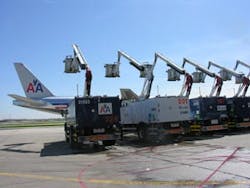Station Visit: American Airlines Deicing at O'Hare
On a warm spring day, clear skies provided a view of operations on the ramp at O’Hare International Airport as planes were prepared to depart. The deicing season has come to a close – yet the American Airlines deicing crew must remain focused on the work to be done in preparation for next season.
Doreen Maples, deicing manager at O’Hare for American Airlines, likens the operation to an orchestra, which takes a great amount of planning and dedication to deliver service seamlessly during a weather event. “When you are in deicing, you eat it, you drink it, you breathe it — a lot of hours are put in,” she says.
A station like O’Hare, where most of the carrier’s deicing takes place, is considered the “gold standard” for the airline, according to Don Borntrager, deice engineering at American Airlines. “We deice probably at about a little over 90 cities and Chicago uses more fluid than everyone else combined,” he says.
To prepare for the harsh weather that Chicago is capable of supplying, the crew will go straight into preparing for the next season, which includes preventive maintenance on the trucks and crew training. “You have a month or two to take your shoes off, but come June or July you’re right back in planning; just making sure you’ve got all your tools ready for the next season,” Maples says.
With about 850 total employees trained for deicing in Chicago (80 active deicing crew members during each shift), the training regiment includes theoretical testing and practical training on the deicing equipment. Recruited from inside airline operations, most of crew members return each year from other departments. The training begins each year in the August/September timeframe.
Equipment
Among the new developments at its station in O’Hare – much excitement has been centered around the addition of 11 new deicing trucks to its fleet. Integrated into a fleet that includes trucks dating back to the 1970s, the airline has phased the new equipment into the fleet over the past few years.
The new features offered by the trucks include onboard blending capability, which allows for the mixture of glycol and water to be applied according to the outside air temperature.
The onboard blending feature differs from that of its older trucks, which spray at a constant 55-percent glycol and 45-percent water mix that has a freeze point of 40 degrees below zero. “To have a 55/45 blend in them full time, probably in 75 percent of the winter, these trucks are going to be twice as strong as they need to be fluid wise,” Borntrager says.
Though the trucks required an initial investment on the part of the airline, the cost savings associated with reduced glycol use, according to Borntrager, is significant. “To go with these trucks for the majority of the deicing year, they are almost saving enough fluid annually to justify one of these trucks,” he says.
Systemwide Planning
American Airlines has largely bucked the trend of outsourcing its deicing operations with the airline performing about 70 percent of its activities throughout the network. That means a lot of systemwide planning must take place to make sure each station is prepared. “When a station plan comes in, we want to know that everyone is geared up and ready to go across the whole system, so we’ve got to do a spreadsheet on everybody who does deicing and keep up to date on everybody who has done their due diligence,” he says.
Also, the airline is able to share lessons between stations. “The way they do things here will be different from what is done at a different station,” he says. “What our office does then is to get feedback from everybody, and we try to incorporate it into next season’s training.”
So while the threat of winter weather might largely be out of mind for many turning the planes on the ramp, the American Airlines deicing crew will remain hard at work to prepare for the next season.
